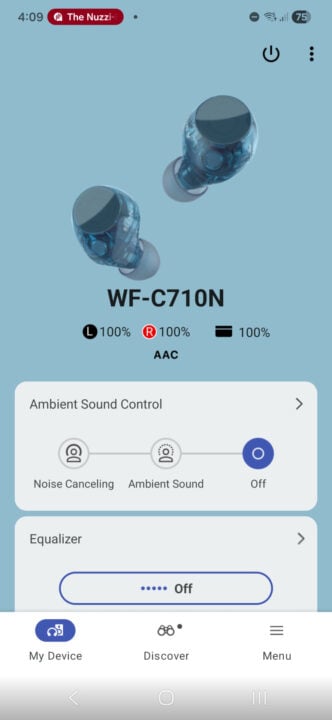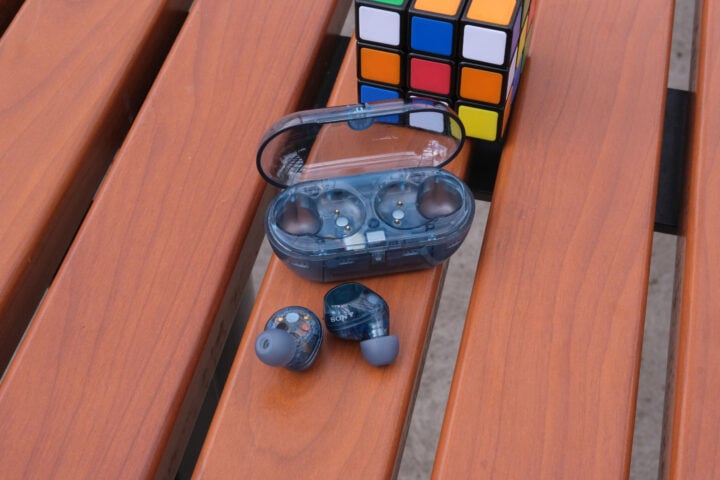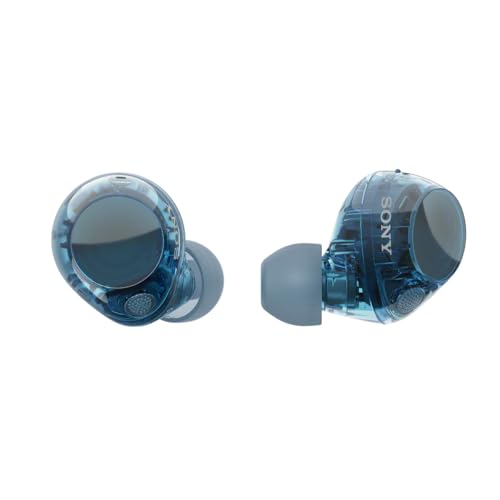What can you say about wireless earphones? The Sony WF-C710 earphones are, like all the others out there, little buds with silicon tips that plug into your ears and otherwise sit in a compact charging case.
But they are different in a number of ways. First, they’re from Sony, so you’ve got a major brand with a good reputation behind it, should there be any problems. Second, they have active noise cancellation.
And from Sony, that means something, seeing as how Sony was the first company – way back in 1996 – to release consumer noise cancelling headphones (the Sony MDR-NC20, which I wrote about in 2019). Of course, even Sony messes up noise cancellation sometimes, so we’ll see.
Table of contents
- About the Sony WF-C710N noise cancelling earphones
- Specifications and price
- Practicalities
- Noise cancellation
- Sound quality
- Who are the Sony WF-C710N earphones for?
About the Sony WF-C710N noise cancelling earphones
As for Sony’s present noise cancelling headphones, the WF-C710N earphones are light in weight: 5.1 grams each with the medium silicon tips (small and large are also provided), and 47.6 grams for the buds and the case together. The case is middling in compactness: 72.5mm by 33.6mm by 34.7mm. Those who wear tight jeans might find it best not to pocket them. The case isn’t precisely flimsy, but after a couple of months of use, I feel that the hinge is not as sturdy as it at first seemed.
But at this point, I pause to remember: $129.95. What should I expect, titanium?
Sony rates these earphones at 8.5 hours of usage until they need to go home to their case, and with the case, another 21.5 hours of charge for 30 hours total. That’s with active noise cancellation. Leave that switched off, and Sony says you’ll get 40 hours total.
The review units were in the “Glass Blue” finish. This is a rather nice transparent look. Also available are rather more boring pink, white and black models. They are supplied with a short USB-C cable for charging.

In addition to the noise cancellation, there’s an “ambient sound” mode, which uses the noise cancelling microphones to feed outside sound into your ears. This actually did a reasonably realistic job.
Less impressive was the quality of my voice on calls and recordings in noisy environments. It was quite choppy and could be hard to understand. It seemed to work fairly well when there wasn’t too much ambient noise.
There are touch controls for both buds. With the appropriate number of taps on the appropriate side, you can pause, play, skip through and backwards through the sound program, raise or lower the volume, cycle through noise cancelling, ambient sound and no action, or answer and hang up calls.
And there is Sony’s “Sound Connect” app (Android or iOS, but I used the former and did all my testing using a Samsung Galaxy S25 phone). First, a complaint about the app: I hate it when companies seem to think that I’ll remember that “Sound Connect” is Sony’s app. I’d really appreciate having Sony in the name so that after a hiatus, I could find it.


That said, Sound Connect works with a whole bunch of Sony Bluetooth products, including its higher-end headphones and its Bluetooth speakers, like the Sony Ult Field 3. This provides several potentially useful functions. One is an equaliser, if you want it. As we’ll see, that’s not really needed with these buds. Another is “Adaptive Sound Control”. You can set this so that it automatically switches the buds to “Ambient Sound”, noise cancellation or “Off” for your location, or for your activity (sitting, walking, running or on public transport). Now that’s a cool feature.
In normal use, the earphones cause playback to pause when they are removed, but this is one of the default behaviours that can be changed in the app.
Given the remarkably low price, it’s probably not surprising that when I googled around for the best price, a couple of bucks was the greatest saving. One oddity, though, was JB Hi-Fi, which was advertising them for $60 off! Well, that’s $60 off a “previous ticketed/advertised price prior to the discount offer”. So, after the discount? $129. Hmmm.
I should also note that Sony said that I may keep these earphones, which I shall. Obviously, Sony had no say in the content of this review.
Sony WF-C710N specifications and price
| Audio | 5mm drivers 20Hz – 20,000Hz frequency range |
| Weight | 5.2g per earphone 38g charging case |
| Audio formats | SBC AAC |
| Connectivity | Bluetooth 5.3 Multipoint connection |
| Estimated battery life | Up to 8.5 hours of music playback with noise cancelling Up to 12 hours of music playback without noise cancelling |
| Price (RRP) | $129.95 |
| Warranty | One year |
| Official website | Sony Australia |
Practicalities
For me, one important practical aspect of their use is how nicely they play with cars. So far, in my experience, car stereos are ridiculously aggressive in seizing control of any Bluetooth device to which they have been paired. Just leaving the stereo switched off doesn’t help. Regardless of the headphones or earphones, when I start my car, after five or ten seconds, the sound stops from the ear gear and starts emerging from the car speakers.
With the buds I was using prior to these – Pixel buds – I had to remove the buds from my ears and put them in their case. Even if I set them to their version of ambient sound, when I got to my destination (often just a few minutes away), they’d lose all control until they’d been reset by a charging case rest.
The Sony WF-C710N earphones were nicely behaved in this regard. They couldn’t stop the car from taking over, but I’d just tap the left earbud to go to ambient mode, and the sound would be adequate for podcasts. With music, of course, I’d take them out to directly hear the car speakers. When I got to my destination, I’d switch off the car and open the door, and soon after, the sound would return to the buds, with them having full control.

I have moved since I last reviewed earbuds, so I couldn’t place the phone on the same rock and walk down the same street to check the effective range. In the electronically cleaner environment in which I now live, I found that I could place my phone on a wall and walk around 30 metres while retaining a solid connection, regardless of the orientation of my head with respect to the phone. With my head pointing the right way, a connection was maintained out to about 80 metres.
That said, I did experience a few dropouts at unexpected times. To be clear, with my phone in my left rear pants pocket, the connection was almost always perfect. But from time to time, there’d be just two or four momentary dropouts. I suspect that it was passing some area of heavy 2.4GHz bandwidth usage, but I couldn’t tell for sure.
That set me exploring the Sound Connect app to choose the better-reliability setting instead of the better-quality setting. Which I did, but it seemingly made no difference. The better-reliability setting typically drops the Bluetooth codec back to SBC, but with my Galaxy S25 and these earphones, it was AAC all the way. Perhaps it dropped the AAC to a lower bitrate version.
Sony WF-C710N noise cancellation
The active noise cancellation of the Sony WF-C710N earphones was, thankfully, quite effective. In everyday use, particularly in crowded shopping centres and food courts, it softened the noise of the surroundings considerably.
Using my fake aeroplane – a video I took some years ago on a turboprop flight from Canberra to Sydney, usually a deafening experience, played back extremely loudly on my very competent computer sound system – the noise cancellation reduced the noise from intolerable to tolerable. Indeed, to the point of being easily able to listen to podcasts, although not quite enough to really enjoy music.
For actual flights, I still use Sony WH-1000XM3 headphones. These simply kill the noise and, of course, can plug into the in-flight entertainment system on those aircraft still using wired connections.
Sound quality
Now, this is where I expected to be disappointed. So many earphones are heavily treble-biased, to the point of being uncomfortable listens, even with simple voice stuff such as podcasts. But there was none of that here. I had no need to resort to the equaliser in the Sound Connect app, because the tonal balance was excellent.
That made for a comfortable, enjoyable and unfatiguing listening experience. Neither was there a lack of treble. It was just about right, and provided nice detail.
And bass? Right now, I have “Once Upon a Time In The West” from Dire Straits’ album Communiqué playing, and the strong bass line is, well, strong and clean. Yes, when the bottom note on the bass is hit midway through, there is a little “doubling” – sufficient second harmonic distortion to be apparent on that note – but if that’s the extent of the weakness, that’s nothing much.
Okay, the strings on Prokofiev’s Romeo and Juliet suites (on Decca, conducted by Lorin Maazel) are nowhere near as sweet as on my multi-thousand-dollar Final Audio D8000 magnetic planar earphones, but you do get what you pay for.
And what you pay for with the Sony WF-C710N earphones is a comfortable, enjoyable listen.
Who are the Sony WF-C710N earphones for?
The Sony WF-C710N earphones are simply great value for money. Despite the low price, you get competent noise reduction, good battery life and very respectable sound. Recommended for those who can’t manage to spend hundreds of dollars on their buds.
GadgetGuy occasionally uses affiliate links and may receive a small commission from purchased products.









